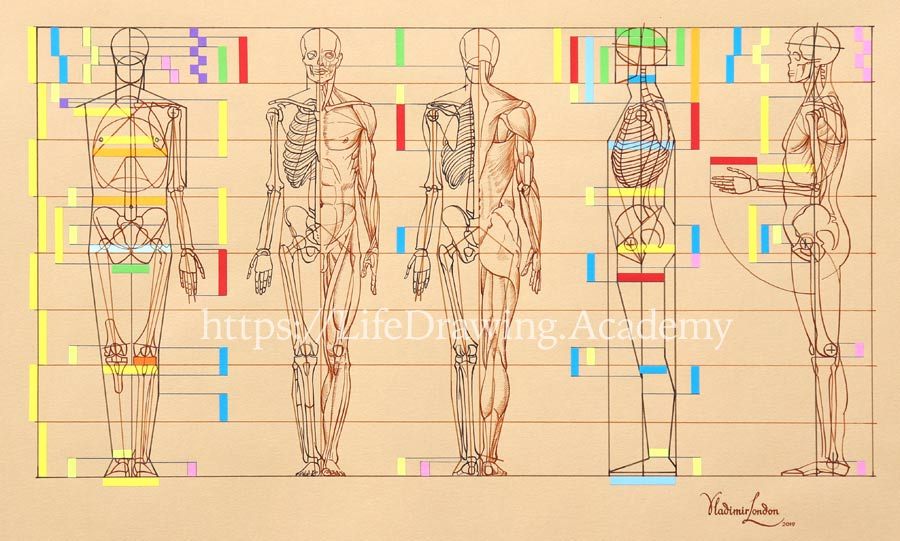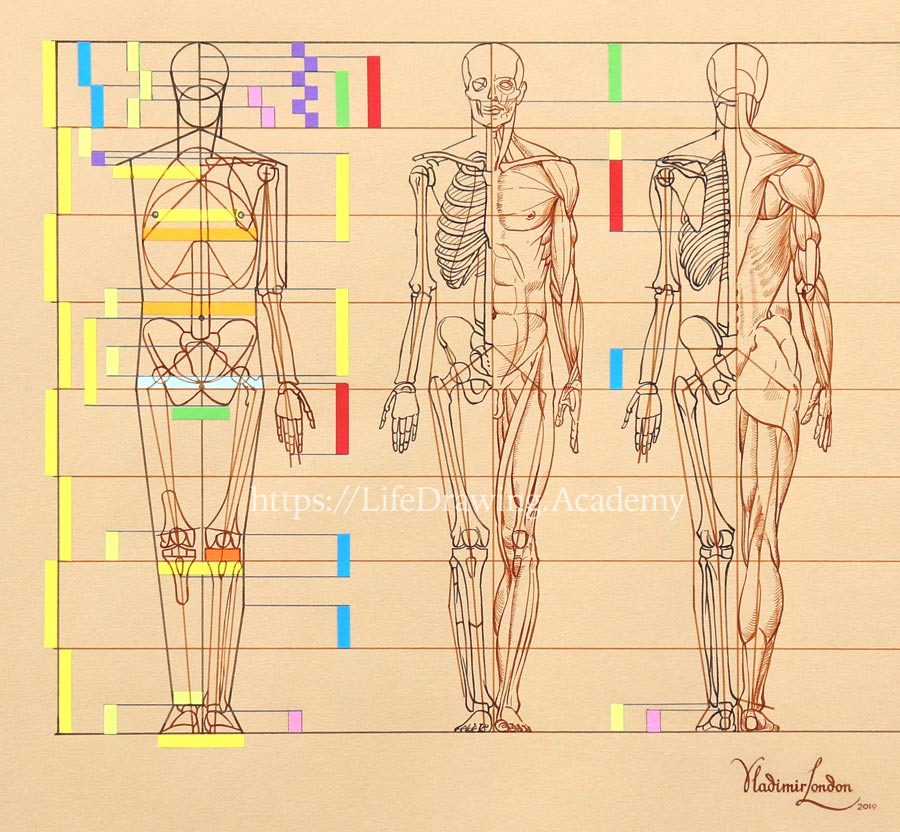Human Body Proportions - Canon 1
This is your unique chance to get a lifetime academy membership and a dedicated team of art teachers.
Such unlimited personal tutoring is not available anywhere else.
Enroll in the Life Drawing Academy now!
Human Body Proportions
Canon 1
By Vladimir London
Before we begin life drawing, we need to talk about the human figure's proportions. During the long history of the arts, sculptors, architects, and artists have come up with different canons of human body proportions. In this video, we will examine the canon whereby a human head fits into a body's height eight times. This canon is well described in a book by Italian art teachers. You can learn more about this book in one of the Life Drawing Academy videos.

For extra precision, I will use the pen and ink medium. Let's start with the top and bottom horizontal lines representing the top of the head and the bottom of the figure. The height of the figure is divided into eight equal parts. I'm using a ruler here to mark those divisions. This is an "engineering" drawing. For life drawing, it is not advisable to use rulers. These eight parts will play an essential role in proportions. The head takes the top part. For now, it is represented by two circles. To color-mark the various proportions, I will use colored paper. If you don't have such paper, it is easy to make your own colors by tinting white paper with watercolor.
Let's come back to the head. Its height fits into the body eight times. I marked this proportion in yellow. The head's height can be divided into two equal parts, marked here in blue. It is also divided into three parts, which coincide with key points of the circles. The small circle is divided into two parts, which are equal to one-fourth of the head. Also, the head's height is divided into six parts. And there are two more measurements—two-thirds of the head, coinciding with the center of the big circle, and five-sixths of the head, which represents the height of the face.
The outlines of the body are oversimplified here. We will use the measurements above for defining the proportions. The ribcage resembles an egg. One-third of the head is the distance from the chin to the pit of the neck. One head is the width of one shoulder. This is also the distance between male nipples. And also the height of the breastbone. The pelvis sits just above the middle of the figure. The height of the head plus one-third gives four-thirds of the head. This measurement is equal to the width of the ribcage and also to the width of the waist. One and a half heads equals the width of male hips. The height of the brain case is the width of the head, which is equal to the distance between the sitting bones. One-third of the head is equal to the distance from the bottom of the ribcage to the top of the pelvis, which also coincides with the navel level. The same one-third is the distance from the hip joints' level to the anterior iliac spine at the pelvis. The height of the pelvis is equal to one head.
Now, we can talk about the arm. In this drawing, it is in a supination position, freely hanging down. One head fits from the elbow to the hip-joint level. The elbow level coincides with the bottom of the ribcage. The height of the face is the length of a hand. One-third of the head is the height of the knee joint. It is also the width of an ankle. And also the height of the foot.
One half of the head is the distance from the top of the kneecap to the bottom of the tuberosity of the tibia. This dimension can also be used to mark the widest point of the calf muscle. Half of the face is another dimension we can use here. It is the same as the width of the knee joint. One-fourth of the head is the height of foot bones. One head is as high as the width of the two feet standing together. One head is also equal to the width of the two knees put together.
Now, I will do a bit more detailed drawing of a male figure. The left part describes its skeletal construction and the right half the muscles of the body.

I will draw in two different shades of sepia ink to differentiate between bones and muscles. The same applies to the back view of the body. Drawing in ink is a very disciplined exercise. Every line has to be precise from the first attempt because erasing and redrawing is not an option. Two-thirds of the head is the height of the brain case. It is the distance from the top of the head to the base of the nose. The distance from the chin level to the acromion level is one-third of the head. The height of the shoulder blade is the same as the height of the face. The bottom of the shoulder blade is at the same level as the insertion of the deltoid muscle. The height of the sacrum's triangle is equal to the half of the head. The distance from the ground to the lateral ankle is one-third of the head. The height of the heel bone is one-quarter of the head.
Now we can use the head to measure the figure in the side view. One head is the depth of the pelvis region. It is also the depth of the waist. The same measurement is the height of the pelvis. And it is also the length of the radius bone. One head is equal to the height of a male breast. The face is also an important measuring unit. It is equal to the length of a hand. One face is the height of the shoulder blade. It is also the depth of a thigh. One-half of the head is equal to the depth of the knee. And it is the height of the knee. Also, it helps to mark the widest part of the calf muscle.
One-half of the head can be also used to locate the turning point of the quadriceps, as well as the vertical plane of the buttocks. One-half of the head is the distance from the pubic bone level, which is the middle of the figure, to the anterior iliac spine at the pelvis.
Here's another measuring unit—the distance from the top of the head to the pit of the neck. This distance is the length of the foot. It is also the depth of the breast. The width of the ribcage, which is equal to the width of the waist, is also equal to the distance from the top of the head to the pit of the neck or top edge of the shoulder blade. Two-thirds of the head is the distance from the chin to the middle of the brain case. This is also the distance from the front of the face to the back of the neck. And also, it is the distance from the back of the head to the front of the neck. Two-thirds of the head, or the height of the brain case, is equal to the width of the pelvis' bottom. One-third of the head is the distance from the chin to the pit of the neck or to the top of the shoulder blade level. It is also the distance from the bottom of the ribcage to the top of the pelvis. It is the height of the knee. It is the height of the foot to the ankle. And the depth of the ankle. It is also the distance from the anterior iliac spine to the hip-joint level. One-fourth of the head is the distance from the middle of the figure to the end of the buttocks. It is the height of the hipbone epicondyle. And it is also the height of the foot bones.
[ The full lesson is avaibale to Life Drawing Academy members ]
This is your unique chance to get a lifetime academy membership and a dedicated team of art teachers.
Such unlimited personal tutoring is not available anywhere else.




